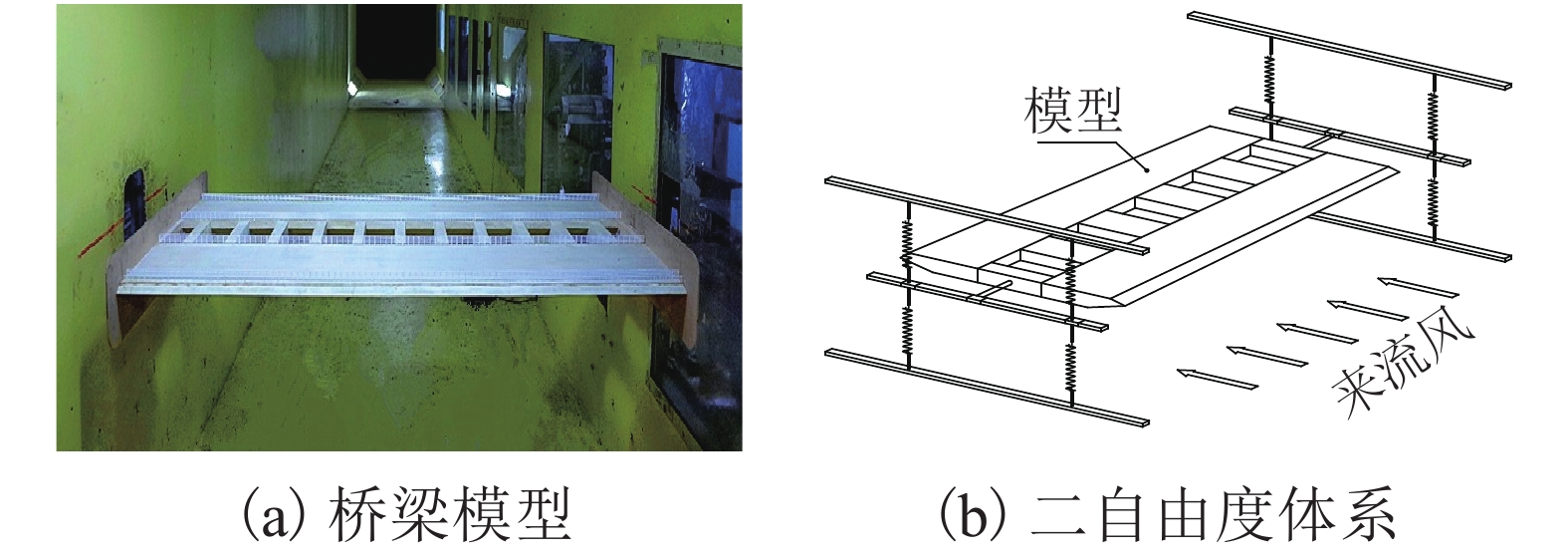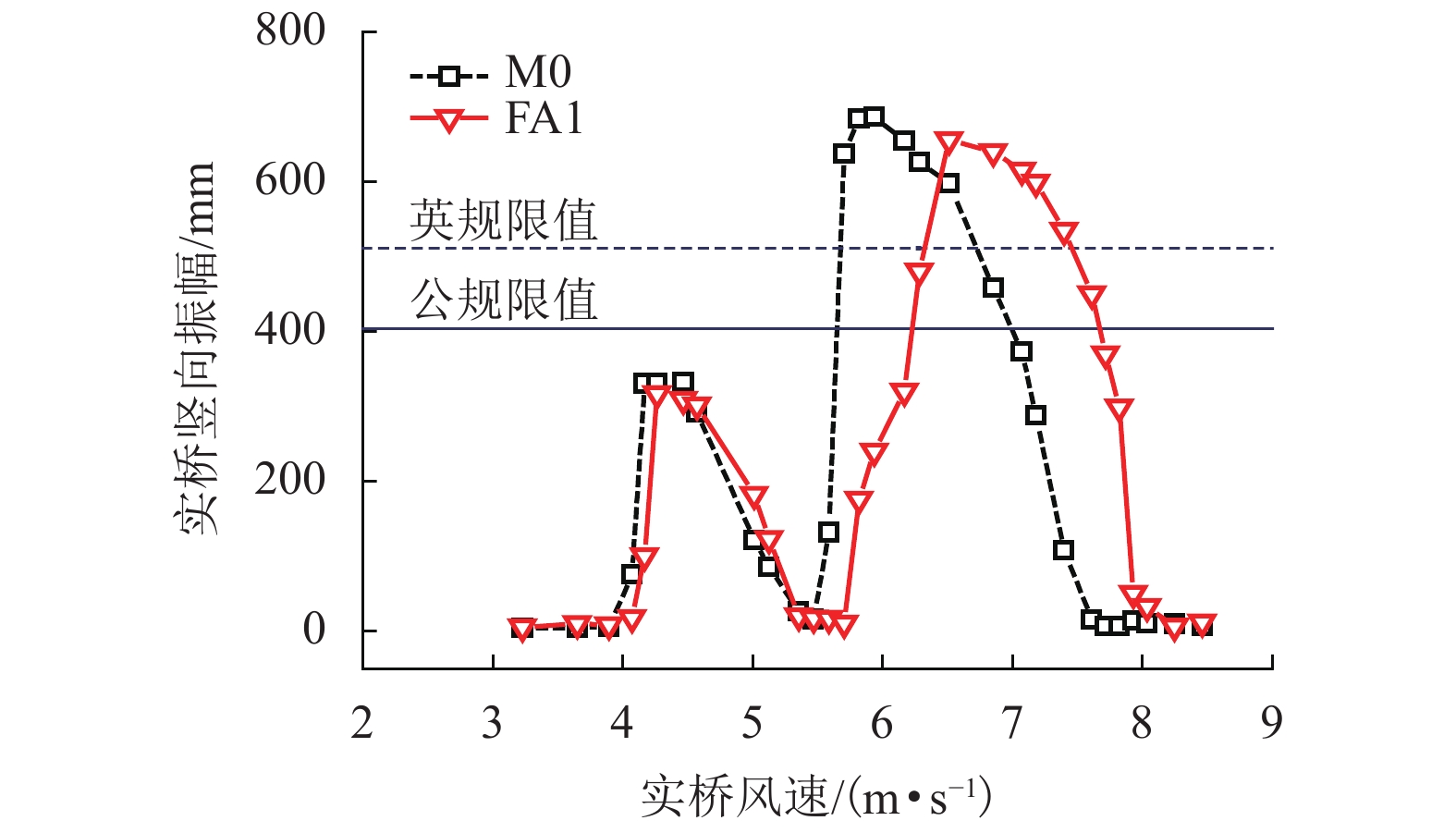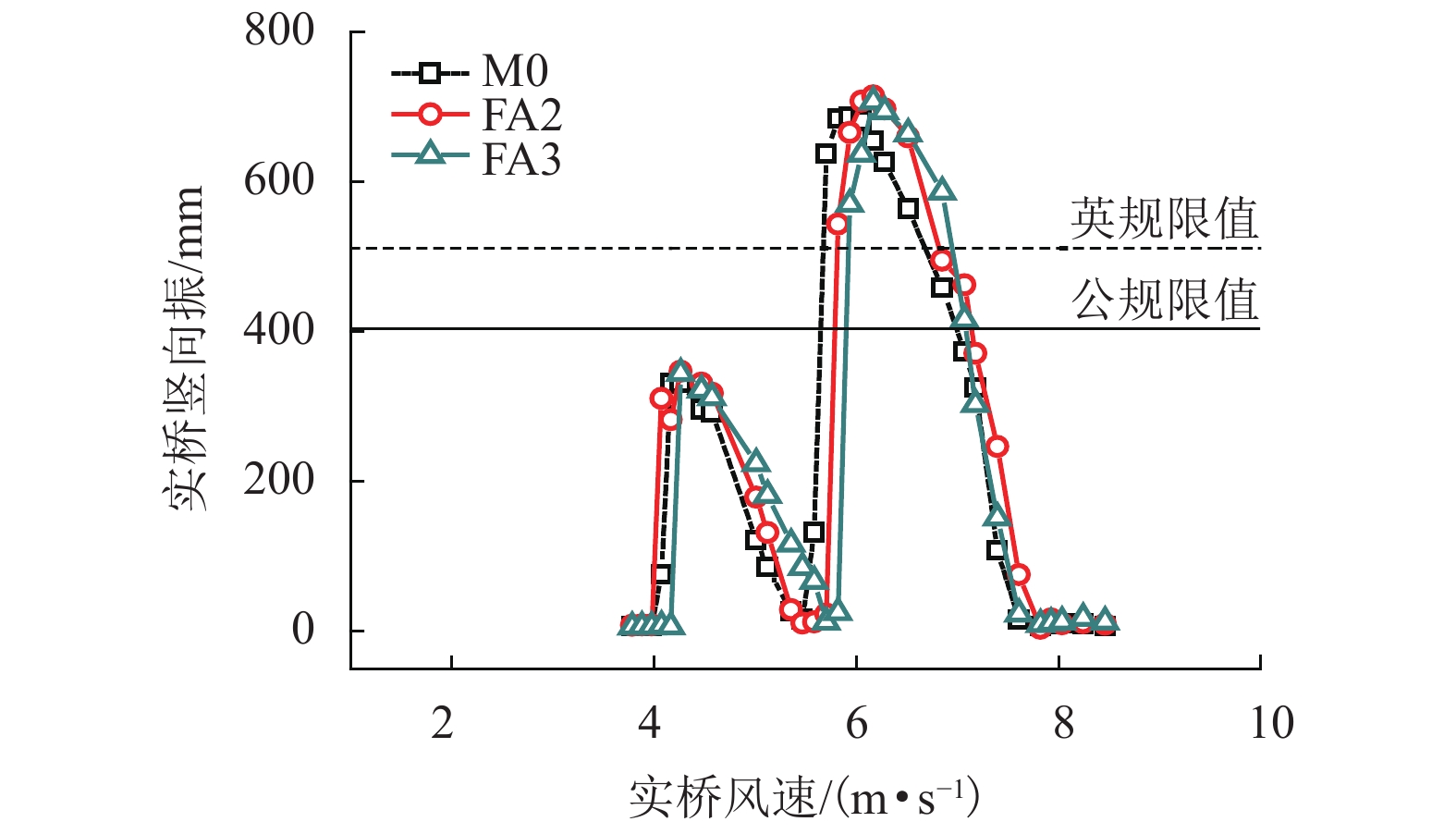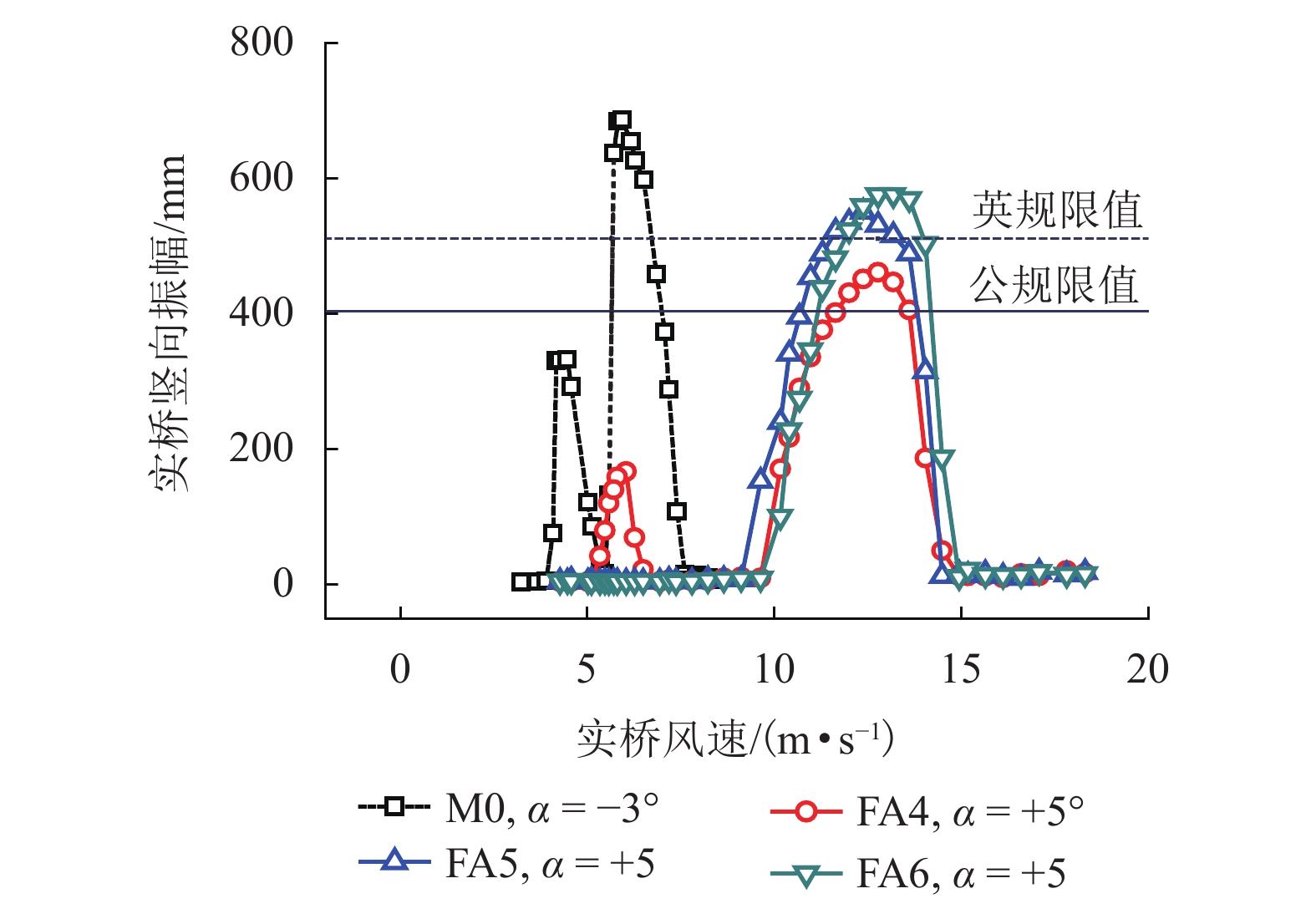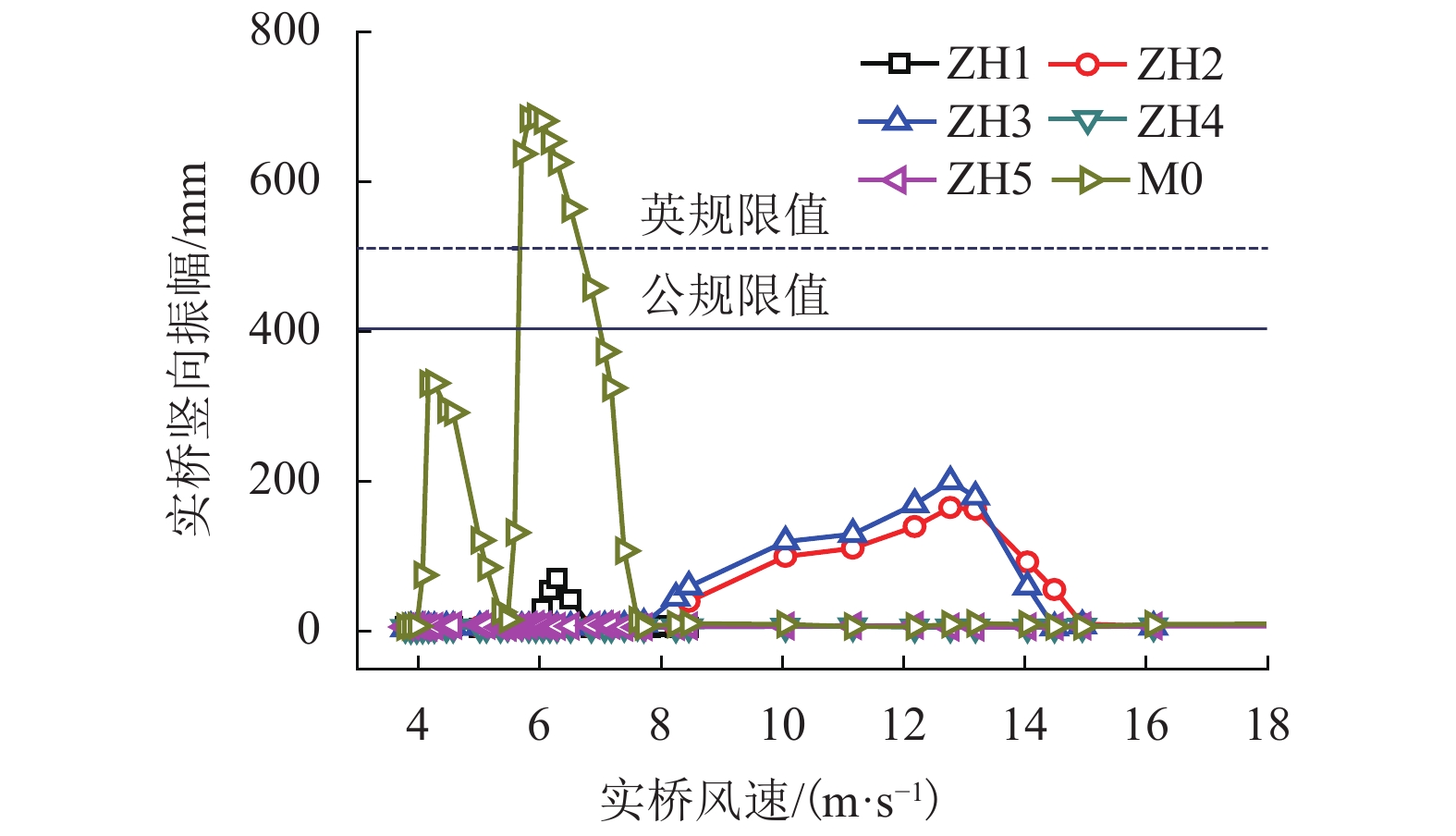Vortex-Induced Vibration Performance and Control Measures of Wide Twin-Box Girder
-
摘要: 为研究宽幅分体箱梁桥梁涡激振动特性及其相应振动抑制方法,以某主梁总宽度为64.1 m的分体箱梁大跨悬索桥为工程背景,在均匀流场下对1∶70缩尺比节段模型进行了风洞试验. 首先研究了主梁成桥态在0°、± 3°和± 5°五种不同来流攻角下的涡激振动特性;其次,考察了单一气动措施(包括设置水平气动翼板、封闭中央开槽、隔涡网以及检修车轨道导流板),以及各种组合措施对主梁涡激振动的影响,检验了这些措施对主梁颤振性能的影响. 研究结果表明:宽幅分体式双箱梁在5个风攻角下均发生了竖向自由度涡激共振,其中最不利攻角为–3°,竖向振幅最大值为0.69 m,超过《公路桥梁抗风设计规范》限值的70%;设置隔涡网和采用组合气动措施后,较原始主梁,涡振振幅下降50.7%~98.6%;尽管抑振措施使主梁颤振临界风速降低6%~15%,但仍满足抗风设计要求.Abstract: In order to study the vortex-induced vibration (VIV) characteristics and control methods of wide twin-box girder bridges, a long-span suspension bridge with twin-box girder and a total girder width of 64.1 m was modeled in a 1∶70 scale ratio and wind tunnel tests for this model were carried out under smooth flow. Firstly, the VIV characteristics of the girder under five attack angles (0°, ± 3°and ± 5°) were studied; secondly, the effects of single aerodynamic measures, including using a horizontal aerodynamic plate, closed central gap, grids and guide plates on overhaul vehicle rail and the effects of the measure combinations were also studied. Finally, the influence of the above aerodynamic measures on the flutter performance of the main girder is examined. The results show that the vertical DOF vortex-induced resonance occurs at all five wind attack angles. The most unfavorable attack angle is –3°, and the maximum vertical vibration amplitude is 0.69 m, which exceeds the limit of the allowable value in Wind-Resistent Design Specification for Highway Bridges by 70%. The combined use of grid and other aerodynamic measures can reduce the VIV amplitude of the main girder by 50.7%–98.6%. However, these control measures reduce the critical flutter wind speed by 6%–15%, which still meets the design requirements.
-
Key words:
- aerodynamic measures /
- twin-box girder /
- vortex-induced vibration /
- wind tunnel test /
- suspension bridge
-
表 1 节段模型试验主要参数
Table 1. Primary parameters for section model in wind tunnel tests
振型 频率/Hz 等效质量/(kg•m–1) 等效质量惯性矩/(kg•m) 阻尼比/% 实桥 模型 实桥 模型 实桥 模型 一阶对称竖弯 0.098 9 2.25 49 073 20.981 0.30~0.40 一阶对称扭转 0.218 2 4.73 29 298 100 2.556 0.36~0.42 表 2 原始断面各风攻角下涡振响应
Table 2. VIV response of original section at different wind attack angles
风攻角/(°) 最大振幅/m 锁定风速/(m•s–1) 斯托洛哈数 +5 0.32/0.59 4.16/5.81 0.106 9 +3 0.30 4.16 0.106 9 0 0.28/0.57 4.16/5.94 0.106 9 –3 0.33/0.69 4.26/5.94 0.104 5 –5 0.33/0.64 4.36/6.16 0.102 1 表 3 气动措施汇总表
Table 3. Aerodynamic measures
方案名称 气动措施 断面示意 FA1 设置水平气动翼板 
FA2 检修车轨道内侧设置导流板 
FA3 检修车轨道双侧设置导流板 
FA4 封闭中央开槽(上表面) 
FA5 封闭中央开槽(下表面) FA6 封闭中央开槽(上、下表面) FA7~AF10 设置隔涡网(透风系数分别为 0.25、0.5、0.75、0.83) 
表 4 气动措施组合
Table 4. Aerodynamic measure combinations
名称 气动措施组合 ZH1 水平气动翼板+中央开槽上表面封闭(FA1+FA4) ZH2 内侧导流板+中央开槽上表面封闭(FA2+FA4) ZH3 双侧导流板+中央开槽上表面封闭(FA2+FA4) ZH4 水平气动翼板+内侧导流板+中央开槽
上表面封闭(FA1+FA2+FA4)ZH5 水平气动翼板+双侧导流板+中央开槽
上表面封闭(FA1+FA3+FA4)表 5 涡振和颤振试验结果
Table 5. Test results of VIV and flutter
工况 涡振振幅/m 改变幅度/% 是否符合《英规》 是否符合《公规》 颤振临界风速/(m•s–1) M0 0.69 N N 99.0 FA1 0.66 –4.3 N N 97.3 FA2 0.71 +2.9 N N 99.5 FA3 0.70 +1.4 N N 99.5 FA4 0.46 –33.3 Y N 83.4 FA5 0.55 –20.3 N N 86.7 FA6 0.58 –15.9 N N 76.5 FA7 0.27 –60.9 Y Y 93.0 FA8 0.01 –98.6 Y Y 90.2 FA9 0.23 –66.7 Y Y 86.3 FA10 0.34 –50.7 Y Y 84.2 ZH1 0.07 –89.6 Y Y 86.4 ZH2 0.17 –75.4 Y Y 85.7 ZH3 0.20 –71.1 Y Y 85.6 ZH4 0.01 –98.6 Y Y 86.6 ZH5 0.01 –98.6 Y Y 87.0 注:表中给出的颤振临界风速均为最不利攻角下主梁断面的颤振临界风速. -
杨詠昕. 大跨度桥梁二维颤振机理及其应用研究[D]. 上海: 同济大学, 2002 曹丰产. 桥梁断面中间开槽对颤振稳定性的影响[J]. 同济大学学报,2002,30(5): 551-556. doi: 10.3321/j.issn:0253-374X.2002.05.005CAO Fengchan. Influence of central slot on bridge box girder’s flutter instability[J]. Journal of Tongji University, 2002, 30(5): 551-556. doi: 10.3321/j.issn:0253-374X.2002.05.005 SATO H, KUSUHARA S, OGI K, et al. Aerodynamic characteristics of super long-span bridges with slotted box girder[J]. Journal of Wind Engineering and Industrial Aerodynamics, 2000, 88(2): 297-306. 艾国柱,夏华日希. 悬索桥的加劲桁架——明石海峡大桥加劲桁架和加劲箱梁的比选[J]. 国外桥梁,2000,4: 15-20. doi: 10.3969/j.issn.1671-7767.2000.04.004 LAROSE G L, LARSEN S V, LARSEN A, et al Sectional model experiments at high reynolds number for the deck of a 1 018 m span cable-stayed bridge[C]. Proceedings of 11th International Conference on Wind Engineering. Lubbock: [s. n.], 2003: 373-380 张伟,魏志刚,杨詠昕,等. 基于高低雷诺数试验的分离双箱涡振性能对比[J]. 同济大学学报,2008,36(1): 6-11. doi: 10.3321/j.issn:0253-374X.2008.01.002ZHANG Wei, WEI Zhigang, YANG Yongxin, et al. Comparison and analysis of vortex induced vibration for twin-box bridge section based on experiments in different reynolds numbers[J]. Journal of Tongji University, 2008, 36(1): 6-11. doi: 10.3321/j.issn:0253-374X.2008.01.002 刘君,廖海黎,万嘉伟,等. 检修车轨道导流板对流线型箱梁涡振的影响[J]. 西南交通大学学报,2015,50(5): 1-7.LIU Jun, LIAO Haili, WAN Jiawei, et al. Effect of guide vane beside maintenance rail on vortex-induced vibration of streamlined box girder[J]. Journal of Southwest Jiaotong University, 2015, 50(5): 1-7. 李翠娟,李永乐,强士中. 分离式双箱主梁断面气动优化措施研究[J]. 土木工程学报,2015,48(11): 55-60.LI Cuijuan, LI Yongle, QIANG Shizhong. Measures of aerodynamic optimization for separated twin-girder decks[J]. China Civil Engineering Journal, 2015, 48(11): 55-60. 廖海黎,王昌将. 西堠门大桥成桥及施工状态下的空气动力特性研究[J]. 公路,2009,1: 24-30. doi: 10.3969/j.issn.1006-3897.2009.17.001 KWOK K C S, QIN X R, FOK C H, et al. Wind-induced pressures around a sectional twin-deck bridge model:effects of gap-width on the aerodynamic forces and vortex shedding mechanisms[J]. Journal of Wind Engineering and Industrial Aerodynamics, 2012, 110: 50-61. doi: 10.1016/j.jweia.2012.07.010 杨婷,周志勇. 中央开槽箱梁涡激共振特性及抑振措施机理研究[J]. 振动与冲击,2015,34(10): 76-83.YANG Ting, ZHOU Zhiyong. Vortex-induced resonance characteristics and anti-vibration measures’ mechanism of central-slotted box girders[J]. Journal of Vibration and Shock, 2015, 34(10): 76-83. 何晗欣,李加武,周建龙. 中央开槽箱形断面斜拉桥的涡激振动试验与分析[J]. 桥梁建设,2012,42(2): 34-40.HE Hanxin, LI Jiawu, ZHOU Jianlong. Testing and analysis of vortex-excited vibration of central slotted box section cable-stayed bridge[J]. Bridge Construction, 2012, 42(2): 34-40. 王骑,林道锦,廖海黎,等. 分体式钢箱梁涡激振动特性及制振措施风洞试验研究[J]. 公路,2013(7): 294-299. doi: 10.3969/j.issn.0451-0712.2013.07.067WANG Qi, LIN Daojin, LIAO Haili, et al. Investigation on the vortex-induced vibration and aerodynamic countermeasures of twin box bridge by wind tunnel tests[J]. Highway, 2013(7): 294-299. doi: 10.3969/j.issn.0451-0712.2013.07.067 LAIMA Shujin, LI hui, CHEN Wenli, et al. Investigation and control of vortex-induced vibration of twin box girders[J]. Journal of Fluids and Structures, 2013, 39: 205-221. doi: 10.1016/j.jfluidstructs.2012.10.009 杨詠昕,周锐,葛耀君. 大跨度分体箱梁桥梁涡振性能及其控制[J]. 土木工程学报,2015,47(12): 107-114.YANG Yongxin, ZHOU Rui, GE Yaojun. Vortex-induced vibration and its control for long-span bridges with twin-box girder[J]. China Civil Engineering Journal, 2015, 47(12): 107-114. 中华人民共和国交通部. 公路桥梁抗风设计规范: JTG D60-01—2004[S]. 北京: 中国标准出版社, 2004 Transport Research Laboratory. Design manual for roads and bridges, part 3: Design rules for aerodynamic effects on bridge: BD 49/01[S]. Wokingharm: Crowthorne House, 2001 李志国,王骑,伍波,等. 不同攻角下扁平箱梁颤振机理[J]. 西南交通大学学报,2018,53(4): 687-695. doi: 10.3969/j.issn.0258-2724.2018.04.004LI Zhiguo, WANG Qi, WU Bo, et al. Flutter mechanism of flat box girder under different attack angles[J]. Journal of Southest Jiaotong University, 2018, 53(4): 687-695. doi: 10.3969/j.issn.0258-2724.2018.04.004 -






 下载:
下载:
